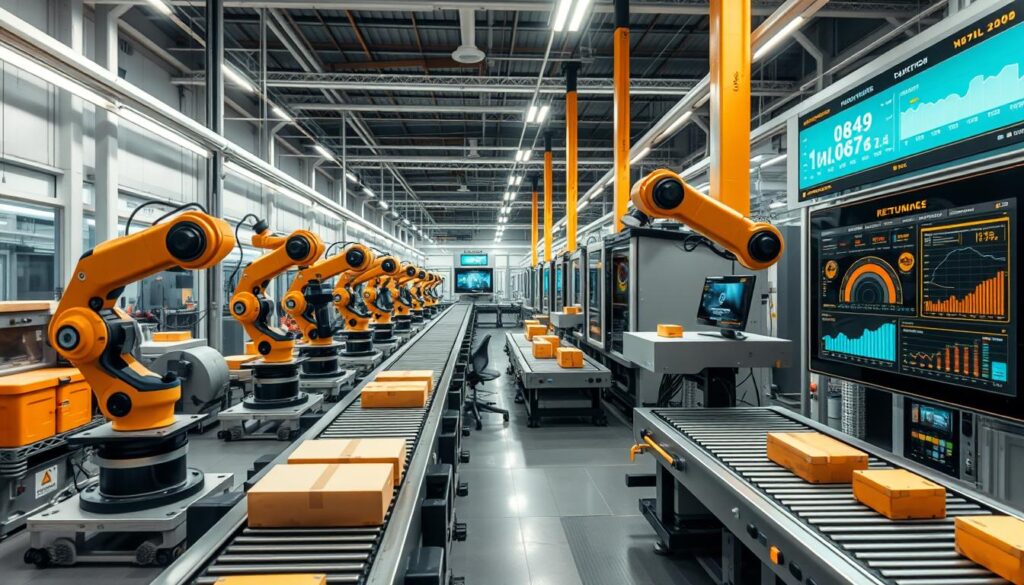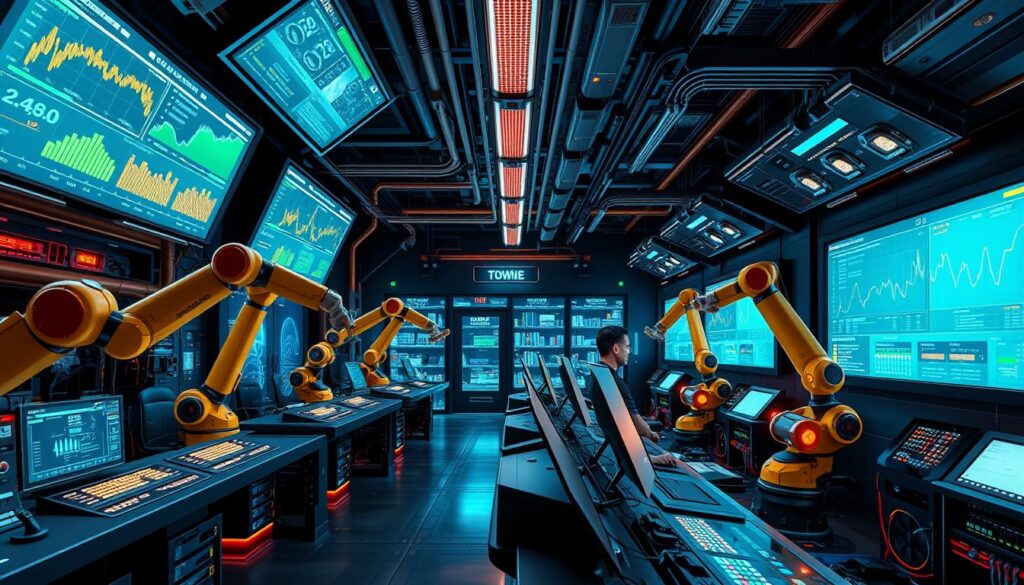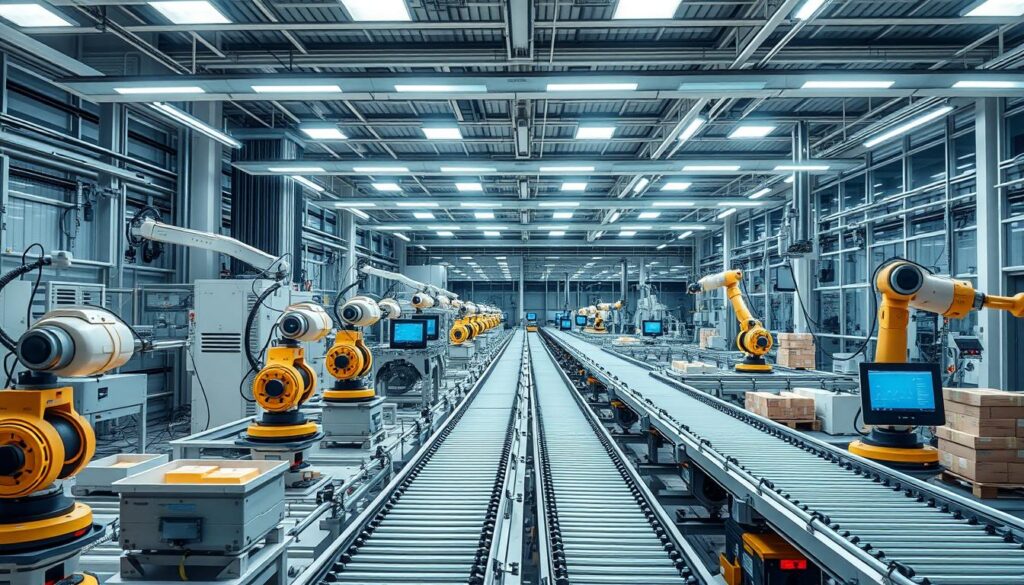The world of industry is always changing. Leading this transformation are advanced automation systems. These systems are changing how productive and secure businesses can be. They help businesses adjust quickly to changes in the market and security needs. In fact, they can reduce security risks by as much as 70%.
Embracing smart manufacturing leads to higher productivity among employees. An impressive 90% of workers say they are more efficient with these technologies. Advanced automation takes over simple tasks and reduces mistakes. This frees up people to focus on complex and strategic work.
Looking closer, these automation systems do more than just simplify tasks. They reduce the need for manual work and improve operations in storage, customer service, and back-office tasks. They use technologies like ASRS and RPA to do this.
These systems make daily work smoother and also have a big impact on global industry trends. They’re changing industries with their incredible efficiency.
Key Takeaways
- Businesses experience significant reduction in operational costs and error rates with the adoption of advanced automation systems.
- Automated tools facilitate improved accuracy and space utilization in logistics, contributing to substantial cost savings.
- Through predictive maintenance and real-time data analytics, advanced automation extends equipment life and optimizes supply chains.
- Implementation of smart manufacturing solutions in diverse industries has bolstered operational efficacy and enriched customer engagement.
- Despite prevalent adoption in larger organizations, a mere 13% of small-to-medium US buildings embrace Building Automation Systems.
- Advanced automation not only conserves energy but also streamlines security operations, enhancing overall building management.
What are Advanced Automation Systems?
Advanced automation systems are the peak of industrial and tech innovation. They mix sophisticated software and hardware. This boosts efficiency in different sectors. They use AI, machine learning, and IoT. This lets them do tasks with little human help. This way, they increase efficiency and make fewer mistakes.
Definition and Overview
Simply put, advanced automation systems use top-notch automated tools to make complex jobs easier. They manage tasks that used to need people. This includes everything from simple machine tasks to big decision-making. So, they make results more precise and better overall.
These systems started with simple inventions, like the Jacquard loom. Now, they’ve grown into smart, automated control systems. These can learn and change with new situations on their own. Want to know more about how they can make your work easier? Check out this useful info on advanced automation software.
Key Components of Automation Systems
The power of advanced automation systems comes from their parts, like:
- Robotic Process Automation (RPA): Automates repetitive tasks, reducing the need for manual input.
- Business Process Management (BPM): Manages and optimizes complex business processes to enhance overall efficiency.
- AI and Machine Learning: Powers decision-making processes, enhancing adaptability and problem-solving capabilities within the system.
- Internet of Things (IoT) Integration: Connects and enables communication between various devices, collecting and analyzing data to optimize performance.
Together, these elements create a solid base for automated technology solutions. They push businesses to new heights of operational efficiency and innovation. They simplify tasks and support constant improvement.
Benefits of Implementing Advanced Automation
The rise of high-tech automation software and automated technology solutions has changed how industries work. These changes lead to big improvements in operational efficiency, saving money, and getting jobs done more accurately.
Increased Operational Efficiency
Embracing advanced automation means a big boost in how well things run. When companies use automated systems, they can keep productivity very high, around 90 percent, and work non-stop. This is very helpful, especially as the number of available workers goes down because older employees are retiring. Automation helps fill this large gap.
Cost Reduction Strategies
Using automated technology doesn’t just make work faster; it also cuts down costs. Companies save on manual labor costs, use less energy, and waste fewer materials thanks to better accuracy. Automated systems quickly make up for their cost by reducing the time and money spent on operations while increasing what’s produced.
Improved Accuracy and Precision
Advanced automation makes production more exact and consistent. High-tech solutions mean tasks are done with more precision. This results in less wasted material and better-quality products. This reliability improves everything from making to delivering products, making customers happier with what they get.

| Benchmark | Impact | Improvement (%) |
|---|---|---|
| Operational Efficiency | Historic figures above 90% | Up to 50 |
| Cost Reduction | Ease of pay-off and reduced operational costs | Up to 30 |
| Production Accuracy | Decreased material waste and errors | Up to 25 |
| Safety Improvement | Reduced exposure to dangerous tasks | Up to 70 |
| Production Output | Capability for 24/7 operations | Up to 45 |
Industries Transforming with Automation
Automation is changing important industries, making them more efficient and boosting the economy. These technologies are important for creating change in different areas.
Manufacturing Sector Innovations
Smart manufacturing is key in the industry. The use of the Industrial Internet of Things (IIoT) and robots that work with people is changing production. By 2025, the world will have 36.8 billion IIoT connections, showing a big move towards connected and automated factories.
Healthcare Automation Solutions
Automation in healthcare brings more accuracy and efficiency. Robots for surgery and AI for diagnosis are making healthcare better. Robots also help in delicate surgeries, making them safer and helping patients recover faster.
Transportation and Logistics Enhancements
Automation changes how goods are moved and delivered. The use of self-driving vehicles and drones makes delivery quicker and more precise. By 2030, the logistics market will be worth $141 billion, showing how much automation can grow this sector. These changes make operations smoother and transportation safer.
| Industry | Automation Impact | Key Technologies |
|---|---|---|
| Manufacturing | Increased production efficiency and flexibility | IIoT, Cobots |
| Healthcare | Improved surgical precision and diagnostics | Robotic Surgery Systems, AI diagnostics |
| Logistics | Enhanced delivery speed and safety | Autonomous Vehicles, Drones |
Choosing the Right Advanced Automation System
As industries grow, the global industrial automation market is set to hit $395 billion by 2029. Picking the right automated systems is key. These systems must match your business goals exactly. It’s about looking into the future of automation. This means choosing systems that are flexible and can grow as market demands change.
Assessing Business Needs
Choosing the right automation starts with knowing your needs and limits. Things like budget and the need for precision are important. You have to decide if you need fixed, programmable, or flexible automation. This decision should fit your production as it is now. Also, it’s key to check if new automation can grow with your business. This way, you won’t have to completely change your system later.
Evaluating System Capabilities
It’s crucial to know what automation systems can do. Pick systems that meet your needs today and have features for top-quality products. For example, programmable automation is great for batches of similar items. Flexible systems are best if you often change product types and don’t want downtime for reprogramming.
Integration with Existing Processes
Systems must fit into your current operations smoothly. The best automation strengthens what you already do without causing problems. This includes systems that bring different automation types together. Or systems that make your workflows better and more efficient through smart integration.
Getting involved in smart robotics can also cut labor costs and make production quicker. Plus, it improves what you make. This is worth thinking about when adding new technology.

Challenges in Advanced Automation Implementation
Many industries are starting to use more advanced automation. However, they often run into implementing automation challenges. It is important to recognize and deal with these obstacles. This helps in making the most of automation technologies.
Common Obstacles Faced
Workforce resistance is a big issue when it comes to automation. Workers worry about losing their jobs and having to adapt to new processes. Also, fitting new automation technologies with old systems is hard. It can lead to separated data and less efficiency. What’s more, some automation tools are too rigid. This makes it hard for a business to keep up with changes.
Strategies to Overcome Challenges
To reduce these problems,
- it’s vital to communicate well and include your team to ease their worries.
- For technical issues, introducing changes step by step and keeping a close watch helps. This makes sure data stays correct.
- Improving staff skills is also key. It keeps employees involved and better prepared for new technology.
Overcoming technical challenges is critical for companies wanting better workflows and growth. This helps by making use of common standards for showing. Plus, linking different techs together makes automation smoother.
Let’s look closer at how automation is changing different sectors:
| Industry | Automation Impact |
|---|---|
| Manufacturing | Makes making things faster through automated lines and quality checks |
| Warehousing and Distribution | Improves keeping track of stock and sending orders with robots and self-driving vehicles |
Future Trends in Advanced Automation Systems
The world of industrial automation is about to change. New technology will blend the digital with the physical. By 2025, AI and machine learning, combined with IoT connectivity, will lead this shift. These changes will drive businesses towards smart growth.
AI and Machine Learning Integration
AI’s role in automation is growing fast. By 2025, it will be crucial in automation systems. It will improve predictive maintenance and quality control. This makes industries more efficient in maintaining equipment and ensuring product quality. The need for AI and robotics experts is increasing. This changes the kind of skills companies look for.
The Role of IoT in Automation
IoT will change how industrial automation works. It will make real-time monitoring and predictive maintenance better. A network of devices will offer a wealth of data. This data leads to better resource use and streamlined operations. Experts in IoT and data analysis will be highly sought after. They will help industries make smarter decisions and work more efficiently.
Predictions for Industry Advancements
In the next few years, we’ll see different new technologies come together. Think 5G, collaborative robots, and Automation as a Service (AaaS). They will create a future where things work together more seamlessly. Sustainability will become more important. This will lead to eco-friendly automation solutions. This reduces harm to the environment. These changes will require workers who are skilled and can adapt to new technologies. They’ll lead the charge in using the advanced automation systems of the future.
FAQ
What defines advanced automation systems and how do they enhance industrial efficiency?
Advanced automation systems consist of technologies like AI, robotics, IoT, and cloud computing. They work with little human help. These technologies boost efficiency by making operations smoother, reducing mistakes, and allowing employees to take on important tasks.
What are the key components that make up advanced automation systems?
Key parts of advanced automation systems include automated controls, industrial tools, high-tech software, smart sensors, and connectivity solutions. These components work together to carry out complex tasks with accuracy and efficiency.
In what ways can implementing advanced automation contribute to operational efficiency?
By adopting advanced automation, operations become more efficient. It reduces the need for manual work, allocates resources better, and improves task accuracy. This boosts worker productivity and makes better use of resources.
How does advanced automation help in reducing operational costs for businesses?
Advanced automation cuts down costs by needing less manual labor and reducing marketing expenses. It also lowers energy use and waste. This makes businesses more profitable and green.
Can you elaborate on the improved accuracy advanced automation systems provide?
Advanced automation systems improve accuracy with smart manufacturing and high-tech software. They ensure tasks are done precisely and production quality stays consistent. This lowers mistakes and makes customers happier.
Which industries are witnessing significant transformations due to advanced automation?
Many industries are changing because of advanced automation. Manufacturing sees automated lines and predictive maintenance. Healthcare benefits from AI and robotic surgeries. Transportation and logistics use autonomous vehicles and real-time tracking.
What are the important factors to consider when choosing the right advanced automation system for a business?
When picking an advanced automation system, businesses should look at their needs, evaluate different new platforms, and plan integration carefully. This ensures the system fits well and works best.
What are the common challenges faced during the implementation of advanced automation systems?
Implementing advanced automation can bring challenges. Issues like integrating systems, keeping data accurate, handling change resistance, and training staff to use new tech are common hurdles.
What strategies can businesses employ to overcome the challenges of implementing advanced automation?
To beat automation challenges, businesses should plan well, check risks, start in phases, monitor systems often, and train their workforce. These steps help smooth out the process.
How are AI and machine learning expected to further enhance advanced automation systems?
AI and machine learning will make advanced automation better by boosting learning, adapting, and decision-making abilities. This leads to smarter, self-governing systems that enhance operations.
What role does IoT play in the advancement of automation technologies?
IoT is key in advancing automation by linking devices and systems. It allows for instant data sharing and enables more cohesive, responsive, and adaptable operations.
What are some predictions for future industry advancements due to advanced automation?
The future holds more efficient and scalable industries, smarter decision-making based on data, and growing connected environments. All thanks to merging automation with AI, machine learning, and IoT.



